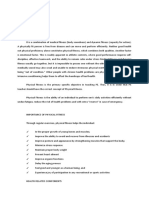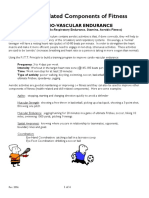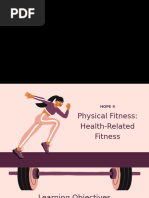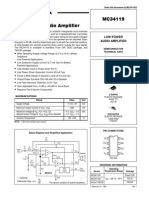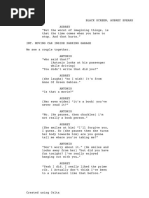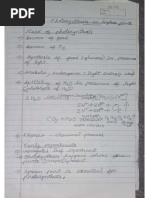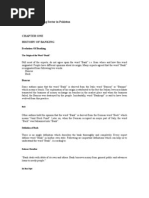0 ratings0% found this document useful (0 votes)
3 viewsLESSON 1 HEALTH AND SKILL RELATED FITNESS 2nd QTR
LESSON 1 HEALTH AND SKILL RELATED FITNESS 2nd QTR
Uploaded by
mirellerhianearcangelthis is for g11 who want to learn about health and their skills and for the students in g11
Copyright:
© All Rights Reserved
Available Formats
Download as PPTX, PDF, TXT or read online from Scribd
LESSON 1 HEALTH AND SKILL RELATED FITNESS 2nd QTR
LESSON 1 HEALTH AND SKILL RELATED FITNESS 2nd QTR
Uploaded by
mirellerhianearcangel0 ratings0% found this document useful (0 votes)
3 views28 pagesthis is for g11 who want to learn about health and their skills and for the students in g11
Original Title
LESSON-1-HEALTH-AND-SKILL-RELATED-FITNESS-2nd-Qtr
Copyright
© © All Rights Reserved
Available Formats
PPTX, PDF, TXT or read online from Scribd
Share this document
Did you find this document useful?
Is this content inappropriate?
this is for g11 who want to learn about health and their skills and for the students in g11
Copyright:
© All Rights Reserved
Available Formats
Download as PPTX, PDF, TXT or read online from Scribd
Download as pptx, pdf, or txt
0 ratings0% found this document useful (0 votes)
3 views28 pagesLESSON 1 HEALTH AND SKILL RELATED FITNESS 2nd QTR
LESSON 1 HEALTH AND SKILL RELATED FITNESS 2nd QTR
Uploaded by
mirellerhianearcangelthis is for g11 who want to learn about health and their skills and for the students in g11
Copyright:
© All Rights Reserved
Available Formats
Download as PPTX, PDF, TXT or read online from Scribd
Download as pptx, pdf, or txt
You are on page 1of 28
Lesson 1
HEALTH AND SKILL
RELATED FITNESS
PHYSICAL FITNESS
• defined as “a set of attribute that people have or achieved that
relates to the ability to perform physical activity” (USDHHS,
1996). In other words, it more than being able to run a long
distance or lift a lot of weight at the gym. Being fit is not
defined only by what kind of activity you do, how long you do
it, or what level of intensity. While these are important
measures of fitness, they only address single areas. Overall
fitness is made up of health and skill related fitness
components.
HEALTH RELATED FITNESS
• Health-related physical fitness is primarily associated
with disease prevention and functional health.
Participating in regular health-related fitness helps you
control your weight, prevents diseases and illness,
improves your mood, boosts energy, and promotes better
sleep.
FIVE COMPONENTS OF
HEALTH-RELATED
FITNESS
CARDIOVASCULAR ENDURANCE
• It is the ability of your heart, blood cells, and lungs to work
continuously for extended periods of time. This is how
efficiently your body takes in, transports, and uses oxygen
while exercising. Having efficient heart and lungs leads to
increased energy throughout the day.
• Also, efficient delivery of oxygen to its tissues will take place
giving the person a lower breathing rate and the ability to
perform the task longer.
MUSCULAR STRENGTH
• The maximum amount of force a muscle can produce in
a single effort or how much you can lift in one attempt.
Performing exercises that use your own body weight,
free weights, or weights on a machine are excellent
ways to develop muscle strength. Having muscular
strength will ensure that you have the strength needed to
lift a heavy object, for example a box full of books.
MUSCULAR ENDURANCE
• the ability of the muscle to continue to perform without
fatigue.
• Another way to think about it is the length of time your
muscles can continue to work before tiring. What this
means is once you have picked up that heavy box of
books, you can then carry that box for a long period of
time before you need to take a break.
FLEXIBILITY
• the range of motion that your joints have during movement.
Maintaining flexibility can improve your performance in
physical activities in addition to decreasing your risk of injuries
by helping your joints move through their full range of motion,
therefore, allowing your muscles to work most effectively.
Stretching and yoga can be done to help improve your
flexibility.
• the ability to bend and move the joints through the full range of
motion
BODY COMPOSITION
• the ratio of water, bone, muscle, and fat in the body. A
healthy body composition indicates that you may have
less risk of developing obesity-related diseases, such as
diabetes, high blood pressure, and even some cancers.
SKILL- OR PERFORMANCE-RELATED FITNESS
• involves skills that will enhance one’s performance in
athletic or sports events. Health-related fitness involves
skills that enable one to become and stay physically
healthy.
SIX SKILL-RELATED
FITNESS COMPONENTS
AGILITY
• is the ability to change and control the direction and
position of the body while maintaining a constant, rapid
motion. For example, changing directions to hit a tennis
ball.
BALANCE
• the ability to control or stabilize the body when a person
is standing still or moving. For example, in-line skating.
• ability of the body to maintain equilibrium
COORDINATION
• the ability to use the senses together with body parts
during movement. For example, dribbling a basketball.
Using hands and eyes together is called hand-eye
coordination.
SPEED
• the ability to move your body or parts of your body swiftly.
Many sports rely on speed to gain advantage over your
opponents. For example, a basketball player making a fast
break to perform a layup, a tennis player moving forward to get
to a drop shot, a football player out running the defense to
receive a pass
• ability to travel in a shortest time possible from Point A to
Point B
POWER
• the ability to move the body parts swiftly while applying the
maximum force of the muscles. Power is a combination of both
speed and muscular strength. For example, fullbacks in football
muscling their way through other players and speeding to
advance the ball and volleyball players getting up to the net
and lifting their bodies high into the air.
REACTION TIME
• the ability to react or respond quickly to what you hear, see, or
feel. For example, an athlete quickly coming off the blocks
early in a swimming or track relay, or stealing a base in
baseball
Physical Fitness Testing
ASSESSING ONE’S HEALTH STATUS WILL HELP THE PERSON KNOW
ABOUT ONE’S STRENGTHS AND WEAKNESSES. AWARENESS OF
INDIVIDUALS’ HEALTH-RELATED FITNESS AND ITS RELEVANT
INTERPRETATIONS WILL AID THE PERSON TO EFFICIENTLY CREATE
AN ACTION PLAN IN OBSERVING A HEALTHY LIFESTYLE AND
SELECTING APPROPRIATE ACTIVITIES FOR AREAS THAT NEED
IMPROVEMENT.
Self –testing Activities for Health-Related Fitness
Click icon to add picture
I. ANTHROPOMETRIC MEASUREMENTS
Purpose: To measure body composition.
Equipment needed: weighing scale, tape measure
Goal: Take body measurements.
Procedure:
1. Height – record in centimeters (cm)
2. Weight – record in kilogram (kg)
3. Waistline - Place a tape measure around your bare stomach just
above the upper hipbone. Record in centimeters (cm).
4. Hipline. Place tape measure in the widest part of
hip in line with the pubis.
5. Computation/s
a. BMI- Body Mass Index - measure of body mass based on height and
weight that aid in determining weight categories.
BMI = Weight in kg / Height in m2
b. Waist to Hip Ratio - measure stored body fats percentage by the
relative measurement of waist and hip
WHR = Waist Circumference (cm) / Hip Circumference (cm)
II. 3 – MINUTE STEP TEST
Purpose: Test for Cardiovascular Endurance level based on how quickly your heart
rate will come back down after a physical activity
Equipment needed: stopwatch, 12-inch bench box, a metronome
Goal: In a constant pace, step on and off the bench for 3 minutes straight
Procedure:
1. Stand close to the 12-inch bench box while partner will set the
metronome in 96 beats per minute (bpm).
2. When ready to begin, start the stopwatch, step one foot at a time to
the beat (up, up, down, down). When 3 minutes is up, stop
immediately get your pulse rate.
3. Record the Exercise Heart Rate: ______bpm
III. HAMSTRING AND HIP FLEXOR TEST
Purpose: To test flexibility of the Hamstring and hips
Equipment needed: protractor
Goal: Keeping both legs straight, lift one leg to the maximum angle
with other leg remain flat on the floor.
Procedure:
1. Lie on your back on the floor beside a wall.
2. Slowly lift one leg off the floor. Keep the other leg flat on the floor.
3. Keep both legs straight.
4. Continue to lift the leg until either leg begins to bend or the lower leg begins to lift off the floor.
5. Place a yardstick against the wall to mark the spot to where the leg was lifted. Lower the leg.
6. Using a protractor, measure the angle created by the floor and theyardstick. The greater the angle the better your score.
7. Repeat with other leg.
IV. ZIPPER TEST
Purpose: Test for the shoulder flexibility
Equipment needed: tape measure
Goal: Raise one arm across back with bent elbow reaching down
fingers of the other hand
Procedure:
Procedure:
1. In standing position, raise one arm across you back,
bend the elbow and reach down as far as possible, simultaneously, bring
other arm down and behind the back trying to cross fingers over those with
the other hand.
2. Measure the distance of overlapped fingers in cm. If they fail to meet score as a minus or <0. Write zero if the fingertips just touched
with no overlap.
3. Repeat the procedure with the other hand. Record the score.
V. CURL – UP (DYNAMIC)
Purpose: Test abdominal muscles strength and endurance
Equipment needed: mat, adhesive tape
Goal: Perform curl-up with proper pacing (3 seconds per curl)
Procedure:
1. Sit on a mat in a long sitting position. Bend your legs more than 90
degrees with feet remaining flat on the floor.
2. Lay down with arms extended at the sides, palm facing down with fingers
extended touching the 1st tape mark.
3. From that position, curl your trunk up with heels in contact with the floor until your fingers reach the 2 nd marker.
4. Upon reaching, lower back to the starting position. Repeat one-curl up every 3 seconds.
5. Continue the curl-ups and stop when you are unable to keep the pace.
VI. 90-DEGREE PUSH–UP (DYNAMIC)
Purpose: Test for the muscles of the upper arm strength and endurance
Equipment needed: mat
Goal: To perform a proper push–up
Procedure:
1. From prone lying position, place the hands just outside the shoulders with elbows bent.
2. Men: Support the body in a push-up position from the toes with back, hip and legs align.
Women: Support the body in a push–up position from the knees instead of toes, with back, hip, and legs
aligned.
3. Lower the body until the upper arm is parallel to the floor or a 90 degrees angle of the bent elbow.
4. Repeat as many times as possible.
VII. FLEXED-ARM SUPPORT (STATIC)
Purpose: Test the muscular strength of the shoulder and upper arm.
Equipment needed: mat, stopwatch
Goal: Hold the push-up position not more than 35 seconds
Procedure:
1. Use the Push-up procedure 1 & 2 for preparatory position.
From the starting position, lower the body until the upper arm
is parallel to the floor and elbow flexed at 90 degrees
(see illustration).
2. Hold the position as long as possible.
3. Record the obtained holding position.
PERFORMANCE TASK NO. 2
CREATE A 5 to 10 MINS. VIDEO showing some Health and Skill –Related Fitness
on the day to day activities. (e.g. flexibility – arms/elbow: cleaning the house, etc.)
• Wear clothes that are comfortable and easy to move around.
• The video must be 5 to 10 minutes long and students can use the camera on their
computer, flip camera or mobile phone.
• Submit video via messenger and reply your complete name.
• Happy blogging, be physically fit and healthy.
You might also like
- Pe ReviewerDocument10 pagesPe ReviewerFaye Hashly AfunggolNo ratings yet
- Mettler-Toledo B520 Weighing Controller User MannualDocument73 pagesMettler-Toledo B520 Weighing Controller User MannualLARRY88% (16)
- PE 103 Movement Enhancement: 7. Prone To Cardiovascular DiseasesDocument14 pagesPE 103 Movement Enhancement: 7. Prone To Cardiovascular Diseasesken jayNo ratings yet
- Accounting and Financial Management in International BusinessDocument29 pagesAccounting and Financial Management in International BusinessReemaNo ratings yet
- Pe 11 Module 6weeks6Document11 pagesPe 11 Module 6weeks6Ailyn RoncalesNo ratings yet
- Lesson 6 HEALTH AND SKILL RELATED FITNESSDocument23 pagesLesson 6 HEALTH AND SKILL RELATED FITNESSRio TomasNo ratings yet
- Beige and Purple Illustrated Physical Education Physical Fitness Educational PresentationDocument25 pagesBeige and Purple Illustrated Physical Education Physical Fitness Educational PresentationMarco ZoletaNo ratings yet
- P.E. 1-GRADE 11 Health and Skill Related FitnessDocument26 pagesP.E. 1-GRADE 11 Health and Skill Related FitnessmapusjessaNo ratings yet
- Physical Fitness: Core ElementsDocument14 pagesPhysical Fitness: Core ElementsMatthewUrielBorcaAplacaNo ratings yet
- Health-Related Components: Lesson 1Document43 pagesHealth-Related Components: Lesson 1Marat MarbellaNo ratings yet
- Pe 7 PresentationDocument70 pagesPe 7 PresentationMarj PogoyNo ratings yet
- UntitledDocument23 pagesUntitledRochelle Ann Narciso RoaNo ratings yet
- For P.E. & Health 12: Department of Education Region VIIDocument16 pagesFor P.E. & Health 12: Department of Education Region VIIClark PonceNo ratings yet
- Forp.E.&Health12: Department of Education Region ViiDocument15 pagesForp.E.&Health12: Department of Education Region Viichinito aikoNo ratings yet
- Pathfit 2Document20 pagesPathfit 2Gemmalyn Aguilar100% (1)
- Fitness Components: XXXX XXXXXXXXXXXXXX Maheen Hashim Khan BurkiDocument49 pagesFitness Components: XXXX XXXXXXXXXXXXXX Maheen Hashim Khan BurkiMuhammad TariqNo ratings yet
- Components of Health Related Fitness LONGDocument6 pagesComponents of Health Related Fitness LONGClark NuevoNo ratings yet
- Pe.1 Lesson 3 Physical FitnessDocument35 pagesPe.1 Lesson 3 Physical FitnessYam YamNo ratings yet
- PEH1 - 1st Semester (Midterm)Document5 pagesPEH1 - 1st Semester (Midterm)Francine Chalcy CanlasNo ratings yet
- Physical FitnessDocument17 pagesPhysical FitnesslopmidNo ratings yet
- PEDocument5 pagesPE67kyk649ggNo ratings yet
- Physical Fitness and Self-TestingDocument5 pagesPhysical Fitness and Self-TestingPinto, Beatrice AngelaNo ratings yet
- Body Mechanics Notes NCM 103 RleDocument16 pagesBody Mechanics Notes NCM 103 RleAubrey Justine GaleonNo ratings yet
- Health & Fitness - HandoutDocument4 pagesHealth & Fitness - HandoutKarthikeyan GuruNo ratings yet
- What Is "Cardio-Respiratory Endurance (Cardio-Respiratory Fitness) ?"Document5 pagesWhat Is "Cardio-Respiratory Endurance (Cardio-Respiratory Fitness) ?"Jhon Rey SedigoNo ratings yet
- LESSON 1 Understanding Health Related Fitness HRFDocument24 pagesLESSON 1 Understanding Health Related Fitness HRFjho4nadiaman598No ratings yet
- PathFit ReviewerDocument4 pagesPathFit Reviewerchaengchong95No ratings yet
- Physical FitnessDocument7 pagesPhysical Fitnessara timcangNo ratings yet
- PE ModuleDocument20 pagesPE ModuleCesarNo ratings yet
- KEY Concepts of FitnessDocument75 pagesKEY Concepts of Fitnessandrew.l0x0lNo ratings yet
- Physical Fitness and PPFTDocument34 pagesPhysical Fitness and PPFTGlenn Durano RantayoNo ratings yet
- Reading Material 3 Path Fit All About Physical FitnessDocument11 pagesReading Material 3 Path Fit All About Physical FitnessJaiseo FunumichiNo ratings yet
- Physical Fitnes-WPS OfficeDocument2 pagesPhysical Fitnes-WPS OfficeAlmira sibulNo ratings yet
- 5 Components of Physical FitnessDocument2 pages5 Components of Physical FitnessGarrenne Caminos AbiñoNo ratings yet
- Health-Related Fitness Components PDFDocument4 pagesHealth-Related Fitness Components PDFCzar Paulo DabonNo ratings yet
- Health-Related Fitness ComponentsDocument4 pagesHealth-Related Fitness ComponentsFadzliana MajidNo ratings yet
- PE Script - 10-09-2020Document4 pagesPE Script - 10-09-2020Jake Role GusiNo ratings yet
- Basic Concepts of Sports Components of Physical Fitness Classification of SportDocument33 pagesBasic Concepts of Sports Components of Physical Fitness Classification of SportHanna Relator DolorNo ratings yet
- Modulepe 1Document4 pagesModulepe 1ChristineNo ratings yet
- Hope - 1 Grade 11: Quarter 1 Week 6 Module 6Document19 pagesHope - 1 Grade 11: Quarter 1 Week 6 Module 6Mark Johnson San Juan100% (3)
- Q2 P.E&HEALTH POINTERS TO REVIEW 1Document4 pagesQ2 P.E&HEALTH POINTERS TO REVIEW 1Sayo Lang Ako AlceraNo ratings yet
- Physical FitnessDocument47 pagesPhysical FitnessdesilvaannekylafloresNo ratings yet
- Physical Fitness MODULE 1Document52 pagesPhysical Fitness MODULE 1Mary Grace Dela PeñaNo ratings yet
- Q1W1 Pe PFTDocument28 pagesQ1W1 Pe PFTEllen May QuinteroNo ratings yet
- Handouts For PFTDocument8 pagesHandouts For PFTJamessNo ratings yet
- HOPE 1 - Q1 - W6 - Mod6Document19 pagesHOPE 1 - Q1 - W6 - Mod6Donajei Rica100% (3)
- 9 HRF SRFDocument33 pages9 HRF SRFrichard aballeNo ratings yet
- PathFit 1 (MOD 2)Document6 pagesPathFit 1 (MOD 2)HazzaNo ratings yet
- Apznzaapgkr9aogbpuunrwporbhjoqmggrhidrtmbvrtq1mc43cl7l Oqpdregdjpmlq76asjpccvauvr3u9khfihjesuwptayyzb7y El...y1vguzfogrery7tcgrsy6oafft32nbzosrcif0majciizt9ftfioet0tlqfsq4azkno3hfctilvedqklbnrqajfx2zfi95n4ymdaxp74gaxe5jrjjxfch Cxw=Document56 pagesApznzaapgkr9aogbpuunrwporbhjoqmggrhidrtmbvrtq1mc43cl7l Oqpdregdjpmlq76asjpccvauvr3u9khfihjesuwptayyzb7y El...y1vguzfogrery7tcgrsy6oafft32nbzosrcif0majciizt9ftfioet0tlqfsq4azkno3hfctilvedqklbnrqajfx2zfi95n4ymdaxp74gaxe5jrjjxfch Cxw=johnlloydsantossssNo ratings yet
- Pe ReviewerDocument11 pagesPe ReviewerJohn Arsen AsuncionNo ratings yet
- Health1relatedskillsrelated 090613133440 Phpapp02Document19 pagesHealth1relatedskillsrelated 090613133440 Phpapp02lovelybautista2006No ratings yet
- Pe 11 Lesson 1Document38 pagesPe 11 Lesson 1Olivia EstrellaNo ratings yet
- PE Lecture (1st Grading)Document6 pagesPE Lecture (1st Grading)Mai Laine VillaruelNo ratings yet
- PATHFIT 10 Lesson 1 2024Document15 pagesPATHFIT 10 Lesson 1 2024Kurt Sta. MariaNo ratings yet
- Q1 - Peh - Lesson 1Document17 pagesQ1 - Peh - Lesson 1maybel cuadranteNo ratings yet
- Physical Training: Carmen Contreras OrtizDocument13 pagesPhysical Training: Carmen Contreras OrtizLucía Ferre AlcarazNo ratings yet
- Module5 and Module6Document22 pagesModule5 and Module6Marianne Jeuyce LuvidiceNo ratings yet
- HOPE 11 - 1st Quarter ReviewerDocument6 pagesHOPE 11 - 1st Quarter ReviewerChexka Right100% (6)
- UntitledDocument6 pagesUntitledShanz HadjirulNo ratings yet
- PE 11 First SemDocument46 pagesPE 11 First SemHazel Joan TanNo ratings yet
- PE Term PaperDocument9 pagesPE Term PaperPaulyn Jhoy FajardoNo ratings yet
- Simplified Strength Training using your Bodyweight and a Towel at Home Vol. 1: Legs/Quads: VolFrom EverandSimplified Strength Training using your Bodyweight and a Towel at Home Vol. 1: Legs/Quads: VolNo ratings yet
- Health Related FitnessDocument24 pagesHealth Related FitnessmirellerhianearcangelNo ratings yet
- Defining ENTREPDocument5 pagesDefining ENTREPmirellerhianearcangelNo ratings yet
- 2.Properties of LiquidsDocument19 pages2.Properties of LiquidsmirellerhianearcangelNo ratings yet
- Work ImmersionDocument8 pagesWork ImmersionmirellerhianearcangelNo ratings yet
- Vendor Registeration Form: Bangalore International Airport LTD.Document2 pagesVendor Registeration Form: Bangalore International Airport LTD.aman3327100% (2)
- Motorola MC34119DTBDocument13 pagesMotorola MC34119DTBsveta9733276No ratings yet
- Workshop 1 TemplateDocument2 pagesWorkshop 1 TemplateJonard OrcinoNo ratings yet
- Sikuli TutorialDocument11 pagesSikuli TutorialConrad CarrikerNo ratings yet
- Faizah SalsabilaDocument1 pageFaizah SalsabilaRuben Paulus JonathanNo ratings yet
- Script The BeginningDocument9 pagesScript The BeginningmadiNo ratings yet
- Instructional Control PresentationDocument54 pagesInstructional Control PresentationLudmilaCândidoNo ratings yet
- Zirconia in DentistryDocument37 pagesZirconia in Dentistryasha docNo ratings yet
- World Bank Report On Environmental and Social Systems Assessment (ESSA)Document143 pagesWorld Bank Report On Environmental and Social Systems Assessment (ESSA)Manpreet KaurNo ratings yet
- 2023 Budget Planner Printable PagesDocument8 pages2023 Budget Planner Printable PagesAzalea ChayNo ratings yet
- Ed 1420 PDFDocument3 pagesEd 1420 PDFsapiencecorp100% (1)
- Thermodynamics NotesDocument3 pagesThermodynamics Notescsmith36No ratings yet
- Classroom Behavior ManagementDocument39 pagesClassroom Behavior ManagementMichael T. Sebullen100% (1)
- Lecture2 Ent281 Chapter 1 (Part2)Document40 pagesLecture2 Ent281 Chapter 1 (Part2)YipNo ratings yet
- AAE Micro ProjectDocument13 pagesAAE Micro Project21AE313 Aman khanNo ratings yet
- ISKCON Desire Tree - Voice Newsletter 016 Sept-08Document8 pagesISKCON Desire Tree - Voice Newsletter 016 Sept-08ISKCON desire treeNo ratings yet
- Photosynthesis in higher plants by Manoj dole sir aakashDocument40 pagesPhotosynthesis in higher plants by Manoj dole sir aakashsaruNo ratings yet
- Modals WorksheetDocument2 pagesModals WorksheetAbbyNo ratings yet
- Lesson 7 Interpret Farm Plans and LayoutsDocument49 pagesLesson 7 Interpret Farm Plans and LayoutsLeo Nino DulceNo ratings yet
- Core Java Question Bank 2 ACTSDocument2 pagesCore Java Question Bank 2 ACTSWhite DevilNo ratings yet
- 07 Income From Property (50 59)Document11 pages07 Income From Property (50 59)jafferyasim100% (2)
- A &P Overview Respiratory SystemDocument16 pagesA &P Overview Respiratory SystemOpeyemi OmolabakeNo ratings yet
- Base SystemDocument13 pagesBase Systemprotocolz0% (1)
- The Suez Canal in Terms of Its Importance As A Trading Route and The Impact of Recent Event-SeptDocument4 pagesThe Suez Canal in Terms of Its Importance As A Trading Route and The Impact of Recent Event-SeptShabNo ratings yet
- Analysis of Banking Sector in PakistanDocument38 pagesAnalysis of Banking Sector in Pakistanuthmankheil89No ratings yet
- CV Example Solutions PDFDocument9 pagesCV Example Solutions PDFAsp Corp SlaveNo ratings yet
- C Programs DocumentDocument15 pagesC Programs DocumentncpraveenNo ratings yet































